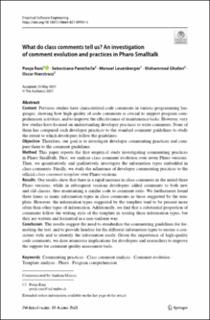Please use this identifier to cite or link to this item:
https://doi.org/10.21256/zhaw-23353| Publication type: | Article in scientific journal |
| Type of review: | Peer review (publication) |
| Title: | What do class comments tell us? : an investigation of comment evolution and practices in Pharo Smalltalk |
| Authors: | Rani, Pooja Panichella, Sebastiano Leuenberger, Manuel Ghafari, Mohammad Nierstrasz, Oscar |
| et. al: | No |
| DOI: | 10.1007/s10664-021-09981-5 10.21256/zhaw-23353 |
| Published in: | Empirical Software Engineering |
| Volume(Issue): | 26 |
| Issue: | 6 |
| Page(s): | 112 |
| Issue Date: | 2021 |
| Publisher / Ed. Institution: | Springer |
| ISSN: | 1382-3256 1573-7616 |
| Language: | English |
| Subjects: | Commenting practice; Class comment analysis; Comment evolution; Template analysis; Pharo; Program comprehension |
| Subject (DDC): | 005: Computer programming, programs and data |
| Abstract: | Context: Previous studies have characterized code comments in various programming languages, showing how high quality of code comments is crucial to support program comprehension activities, and to improve the effectiveness of maintenance tasks. However, very few studies have focused on understanding developer practices to write comments. None of them has compared such developer practices to the standard comment guidelines to study the extent to which developers follow the guidelines. Objective: Therefore, our goal is to investigate developer commenting practices and compare them to the comment guidelines. Method: This paper reports the first empirical study investigating commenting practices in Pharo Smalltalk. First, we analyze class comment evolution over seven Pharo versions. Then, we quantitatively and qualitatively investigate the information types embedded in class comments. Finally, we study the adherence of developer commenting practices to the official class comment template over Pharo versions. Results: Our results show that there is a rapid increase in class comments in the initial three Pharo versions, while in subsequent versions developers added comments to both new and old classes, thus maintaining a similar code to comment ratio. We furthermore found three times as many information types in class comments as those suggested by the template. However, the information types suggested by the template tend to be present more often than other types of information. Additionally, we find that a substantial proportion of comments follow the writing style of the template in writing these information types, but they are written and formatted in a non-uniform way. Conclusion: The results suggest the need to standardize the commenting guidelines for formatting the text, and to provide headers for the different information types to ensure a consistent style and to identify the information easily. Given the importance of high quality code comments, we draw numerous implications for developers and researchers to improve the support for comment quality assessment tools. |
| URI: | https://digitalcollection.zhaw.ch/handle/11475/23353 |
| Fulltext version: | Published version |
| License (according to publishing contract): | CC BY 4.0: Attribution 4.0 International |
| Departement: | School of Engineering |
| Organisational Unit: | Institute of Computer Science (InIT) |
| Appears in collections: | Publikationen School of Engineering |
Files in This Item:
| File | Description | Size | Format | |
|---|---|---|---|---|
| 2021_Rani-etal_What-do-class-comments-tell-us.pdf | 4.64 MB | Adobe PDF |  View/Open |
Show full item record
Rani, P., Panichella, S., Leuenberger, M., Ghafari, M., & Nierstrasz, O. (2021). What do class comments tell us? : an investigation of comment evolution and practices in Pharo Smalltalk. Empirical Software Engineering, 26(6), 112. https://doi.org/10.1007/s10664-021-09981-5
Rani, P. et al. (2021) ‘What do class comments tell us? : an investigation of comment evolution and practices in Pharo Smalltalk’, Empirical Software Engineering, 26(6), p. 112. Available at: https://doi.org/10.1007/s10664-021-09981-5.
P. Rani, S. Panichella, M. Leuenberger, M. Ghafari, and O. Nierstrasz, “What do class comments tell us? : an investigation of comment evolution and practices in Pharo Smalltalk,” Empirical Software Engineering, vol. 26, no. 6, p. 112, 2021, doi: 10.1007/s10664-021-09981-5.
RANI, Pooja, Sebastiano PANICHELLA, Manuel LEUENBERGER, Mohammad GHAFARI und Oscar NIERSTRASZ, 2021. What do class comments tell us? : an investigation of comment evolution and practices in Pharo Smalltalk. Empirical Software Engineering. 2021. Bd. 26, Nr. 6, S. 112. DOI 10.1007/s10664-021-09981-5
Rani, Pooja, Sebastiano Panichella, Manuel Leuenberger, Mohammad Ghafari, and Oscar Nierstrasz. 2021. “What Do Class Comments Tell Us? : An Investigation of Comment Evolution and Practices in Pharo Smalltalk.” Empirical Software Engineering 26 (6): 112. https://doi.org/10.1007/s10664-021-09981-5.
Rani, Pooja, et al. “What Do Class Comments Tell Us? : An Investigation of Comment Evolution and Practices in Pharo Smalltalk.” Empirical Software Engineering, vol. 26, no. 6, 2021, p. 112, https://doi.org/10.1007/s10664-021-09981-5.
Items in DSpace are protected by copyright, with all rights reserved, unless otherwise indicated.